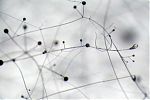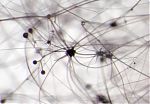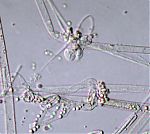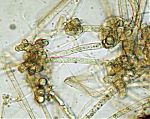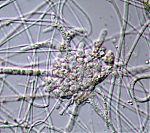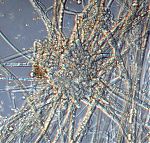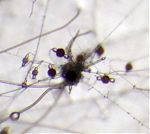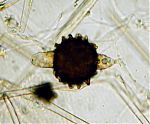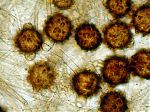Lentamyces
Lentamyces Kerst. Hoffm. & K. Voigt, 2009 (Plant Biology 10: 550).
Colonies slow growing, 1-3 mm high without a host, galls formed on a suceptable host. No growth above 30 C; mesophilic. Subaerial hyphae with sucker-like branches. Stolons and rhizoids produced. Sporangiophores simple or branched, with a subsporangial septum. Sporangia globose to obpiriform, apophysate, wall deliquescing. Columella more or less globose, smooth, without a spine. Sporangiospores ovoid, relatively small. Zygospores globose, brown, wall ornamented; suspensors opposed, hemisphaerical, without appendages. Homothallic.
Type species: L. parricida.
Species of Lentamyces:
L. parricida (Renner & Muskat ex Hesseltine & J.J. Ellis) Kerst. Hoffm. & K. Voigt, 2009 (Plant Biology 10: 550).
= Absidia parricida Renner & Muskat ex Hesseltine & J.J. Ellis, 1964 (Mycologia 56:577) emend. Hesseltine & J.J. Ellis, 1966 (Mycologia 58:771).
= Absidia parasitica Muskat, 1955 (Arch. Microbiol. 22:15); nom. inval., Art, 32.1(d) of the ICBN (McNeill et al., 2006).
L. zychae (Hesseltine & J.J. Ellis) Kerst. Hoffm. & K. Voigt, 2009 (Plant Biology 10: 551).
= A. zychae Hesseltine & J.J. Ellis, 1966 (Mycologia 58:768).
The first isolate of L. parricida was made in Tunesia (Renner and Muskat, 1958). Hesseltine and Ellis (1964) later validated the species with a Latin diagnosis and using Figs. 1 and 9 of Renner and Muskat as the type illustrations; a culture was not available. The strain used in most descriptions and made the neotype for the species was isolated in the United Kingdom (Hesseltine and Ellis, 1966). Wrosek and Gajowniczek (1998) isolated L. parricida several times in Poland. The illustrations published here were taken of an isolate of Lentamyces parricida that was isolated from soil collected in Amherst, Massachusetts, U.S.A., in 2003.
Schipper (1990) treated A. parricida as a species of uncertain position in Absidia because it produced sucker-like branches and slow growth over a temperature range of 15 C (15-30 C), and it is a facultative mycoparasite of other Mucorales. Absidia zychae also was included here also for these reasons although it is a not mycoparasite. This year Hoffman et al. (2007), using sequence based phylogeny, demonstrated that A. parricida and A. zychae are sister species in a clade distinct from Mycocladus spp. and the other taxa of Absidia. The latter species, A. parricida and A. zychae were transferred to Lentamyces by Hoffmann and Voigt (2009).
Bibliography
Hesseltine, C.W., and J.J. Ellis. 1964. The genus Absidia: Gongronella and cylindrical-spored species of Absidia. Mycologia 56;568-601.
Hesseltine, C.W., and J.J. Ellis. 1966. Species of Absidia with ovoid sporangiospores. I. Mycologia 58:761-785.
Hoffmann K, Discher S, Voigt K. 2007. Revision of the genus Absidia (Mucorales, Zygomycetes) based on physiological, phylogenetic, and morphological characters; thermotolerant Absidia spp. form a coherent group, the Mycocladiaceae fam. nov., Mycological Research 111: 1169-1183.
Hoffman, K. and K. Voigt. 2009. Absidia parricida plays a dominant role in biotrophic fusion parasitism among mucoralean fungi (Zygomycetes): Lentamyces, a new genus for A. parricida and A. zychae. Plant Biology 10: 537-554).
McNeill, J., F.R. Barrie, H.M. Burdet, V. Demoulin, D.L. Hawksworth, K. Marhold, D.H. Nicolson, J. Prado, P.C. Silva, J.E. Skog, J.H. Wiersema and N.J. Turland. [eds.]. 2006. International code of botanical nomenclature (Vienna code). [Regnum Vegetabile Vol. 126]. A.R.G. Gantner Verlag KG, Ruggell, Liechtenstein. 568 p.
Milko, A.A. 1970. Genus Absidia van Tieghem (Mucorales). Novitates Systematicae Plantarum non Vascularum 7:121-138.
Muskat, J. 1955. Untersuchungen über Schimmelpilze bayrischer und tunischer Böden. Arch. Mikrolbiol. 22:1-20.
Renner, O., and J. Muskat. 1958. Ãœber zwei neue Arten von Absidia aus Tunesien, A. parricida und A. tuneta. Planta 51:786-802.
Schipper, M.A.A. 1990. Notes on Mucorales—I. Observations on Absidia. Persoonia 14:133-148.
Wrzosak, M., and Z. Gajowniczek. 1998. Some zygomycetous fungi new to Poland. Acta Mycologica 33:265-271.
Updated May 31, 2010

